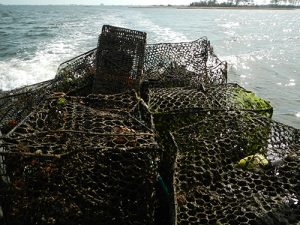
OCEAN CITY – The Maryland Coastal Bays Program (MCBP), along with a team of local watermen and volunteers successfully removed dozens of hidden “ghost” crab pots from the waters, in and around the resort area that were either abandoned or lost, causing a danger to several species along with navigation.
The MCBP recently partnered with local watermen and volunteers to remove marine debris with a focus on abandoned crab pots from the local bays. Crabber Skip Maisel, along with first mate Charlie Travers and Assateague Conservation Corps volunteers, spent two days on the water seeking and retrieving abandoned “ghost” crab pots. Fifty-five derelict pots in various stages of deterioration were removed from the water and transported locally for recycling.
Occasionally, a crab pot can become detached from its buoy or forgotten. These lost pots, known as “ghost pots,” are still able to continue catching crabs, fish, and terrapins. Even after the original bait is gone, the pots “re-bait” themselves. As new animals get trapped in the pots and die, they attract others that then become trapped as well. One study estimated that there are 85,000 ghost pots in the Maryland portion of Chesapeake Bay alone.
Crab pots are lost due to a variety of causes, such as gear conflicts, storm events, or debris catching the pots. However, the majority of crab pots lost in Maryland are due to boat propellers cutting the line. The easiest way to prevent this from occurring is to avoid crab pot marker floats. Not only does hitting a buoy lose the crab pot, but the boat’s props can also be damaged from getting tangled in the line.
There are several reasons crab pots become “ghost” pots and need to be removed from local waters on an annual basis. The majority of the crab pots removed during the recent effort by the MCBP and its partners were commercial pots. Often, they become abandoned only when careless boaters fail to yield to floats in the bays, marking the location of the pots, and cutting the float. Watermen are then unable to find their pots and they become abandoned debris. One location of abandoned pots in Manklin Creek was reported by a local resident and MCBP, Maisel, and crew quickly responded.
According to Sandi Smith, from the MCBP, last summer on Assawoman Bay, one abandoned crab pot contained over 30 dead diamondback terrapin turtles.
“Terrapins are attracted to the same type of food source as blue crabs,” she said. “Once a turtle gets into the pot, it is unable to get out. As terrapins are air breathers, once trapped, they eventually drown.”
On the recent reconnaissance mission, volunteers checked each pulled pot for by-catch. There were no terrapin remains found in these pots, but research has shown that terrapins decompose very rapidly. Blue crabs and various fish species, such as oyster toadfish and flounder, were found in several of the pots, both dead and alive.
Abandoned crab pots are only removed after crabbing season ends, so that there is little risk pulling a legal pot. Crabbing season in the Maryland coast-al bays begins in March and ends in October. If coastal bays residents observe what appears to be an abandoned pot, they are urged to contact the Maryland Natural Resource Police (NRP), as they can investigate and take appropriate action during the crabbing season.
Remember, if one does not hold a commercial crabbing license, they are not permitted to use crab pots in open water.

